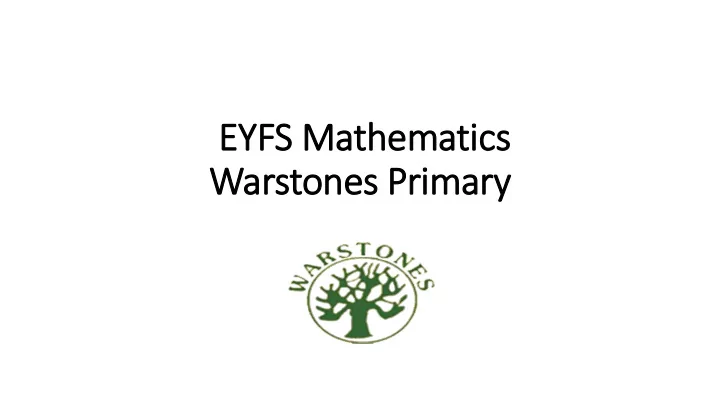

EYFS Mathematics Warstones Primary ry
Why is maths so important? • Maths is everywhere in the world around them. • They will need to be able to use maths in everyday life. • Maths enables children to think logically and become good problem solvers. Therefore: • It is vital to lay secure foundations in early mathematics. • We want children to engage with all areas of mathematics. • We must give children the tools to help them to develop a better understanding of the mathematical world in which they live.
Good practice in the teaching and learning of f Mathematics • Children are given clear purposes and context for mathematics that are real in life and in play. • First hand experiences both indoors and outdoors. • Adults modelling how to be a mathematician • Sustained shared mathematical thinking between adult and child is essential.
How we teach and support children’s mathematical le learning at t Warstones Pri rimary • By having a mathematical rich environment • Whole class teacher directed learning. • Small group work activities. • Enhanced provision in response to needs and interests of the children to encourage the exploration of mathematical concepts.
What is Mathematics? It involves: • working with numbers (including calculating) • shapes, space and measures. The following strands are embedded in our teaching of the above areas: • seeking patterns, • making connections, • recognising relationships, • counting, sorting and matching.
Numbers •Counting songs and rhymes. •One to One correspondence
Counting Questions to do with this activity: • How many are there? • How many would we have if we had one more? • How many would we have if we had one less? • How many would we have if we had double? • How many would we have if we had half?
Number Recognition Number fans and digit cards Number lines Numicon
Numbers - calculating The children use a variety of resources to solve addition and subtraction problems.
Using the number line • Counting up and down the line. • Addition problems activity. • Subtraction problems activity.
Measure • We begin learning how to measure by first comparing and ordering length and height and then by using non-standard units.
Any Questions?
Recommend
More recommend